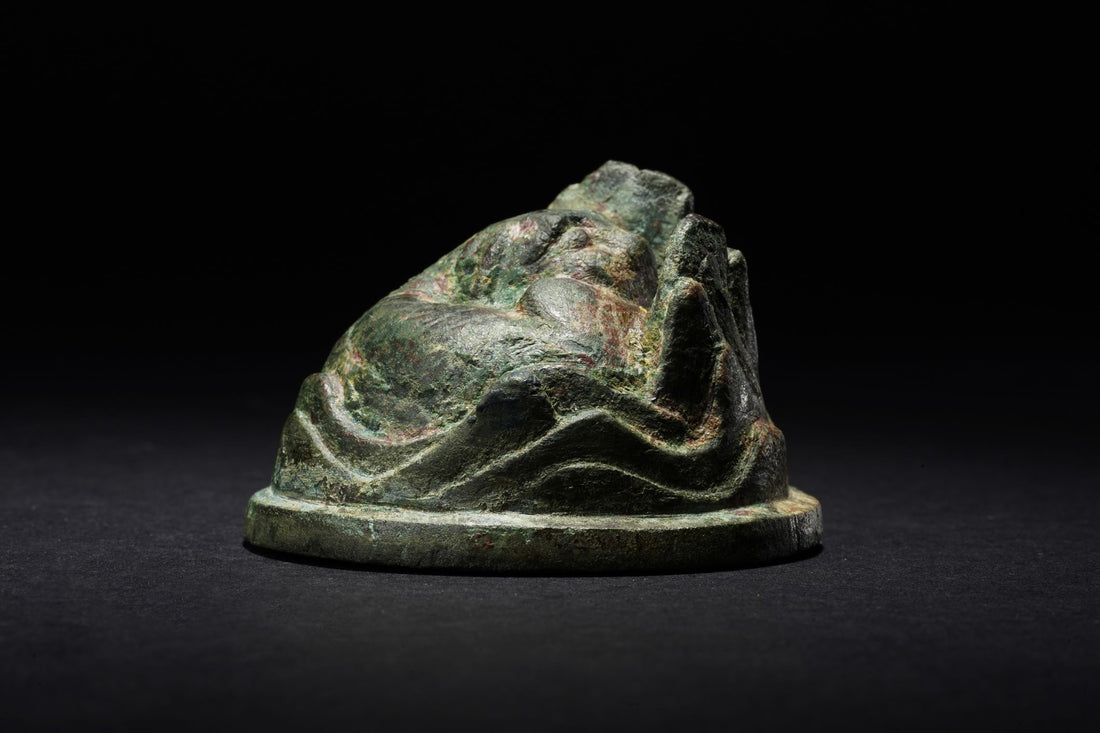
Huwoshan Town

Before high-rise furniture was introduced to China, people had always been accustomed to sitting on the ground, and mats had always been a common living utensil for ancient people. Mats woven with rattan, reeds, cattails or bamboo strips are not only easy to curl, but also move when standing up, so mat weights came into being. "The Book of Songs·Bei Feng·Bai Zhou" says: "My heart is not a mat, it cannot be rolled up." This confirms the easy-to-roll feature of ancient straw mats.


As early as the Warring States Period, mat weights were very popular. Most of the exquisitely made ones came from Han tombs, with various materials and shapes. The diversity of materials can also be seen from the records of some ancient documents: "Chu Ci·Xiang Furen" records "white jade is used as a weight"; Zou Yang, a writer of the Western Han Dynasty, once said in "Wine Fu": "An Guangzuo, a carved screen, a gauze as a mat, and a rhinoceros horn as a weight." In addition, bronze mat weights were also very common in the lives of princes and nobles in the Han Dynasty.
The weights in the Warring States Period were mainly divided into two types: the weights in the shape of a scale hammer and the shape of a lid. In the Han Dynasty, the mat town was a grand spectacle, with shapes such as tigers, leopards, phoenixes, evil spirits, sheep, deer, bears, turtles, snakes, and figures; in terms of craftsmanship, there were gilding, inlaid gold and silver, inlaid shells, etc., and there were many different styles. The Western Han Dynasty was the heyday of the use and production of the town. A large number of unearthed objects and documentary records tell us that the people of the Western Han Dynasty not only regarded the town as a tool for tying curtains or mat corners, but also as a symbol with the intention of warding off evil spirits and eliminating evil.


Before the Wei and Jin Dynasties, the ancients sat on the ground, that is, on straw mats spread on the ground. The homes of royal nobles had low beds, and mats were also spread on them. The four corners were often pressed down with town. In addition to practical functions, it also has the function of warding off evil spirits and eliminating evil. There were physical remains in the Spring and Autumn Period and the Warring States Period. Except for a small number of figures, the shapes of the mat town are mostly animals. Common ones are tigers, lions, leopards, turtles, deer, sheep, etc. People in the Han Dynasty regarded them as animals that eliminate evil and bring good fortune. These animals are usually crouched, coiled, with a flat bottom, and they maintain a certain weight. They are mostly made of metal and jade, which is convenient for pressing objects. This is the main feature of the mat town.
This Han Dynasty tiger lying on the mountain town is a representative of the town in the Han Dynasty. The tiger is in a crouching position, resting against the mountain. The overall shape is vivid and lifelike. The green rust on the town is bright and well preserved. It is very precious.


![8.3"China Shang Dynasty,Bronze wine cup [Fuhao Jue cup][妇好爵杯]](http://bronzc.com/cdn/shop/files/4ee0482982cfa89bb4d1cff3333a55e6_e3ca0b86-22fc-497d-9afd-578c551225a3-2.jpg?v=1733986652&width=533)

![12.8" China Ming Dynasty, Phoenix-patterned bronze vase[Ming Wanli Phoenix-patterned vase][明万历凤纹瓶]](http://bronzc.com/cdn/shop/files/4ee0482982cfa89bb4d1cff3333a55e6_a516991b-2bb9-4b2f-a2b6-4354129d006c.jpg?v=1733986953&width=533)

![14.6" China Eastern Han Dynasty Bronze vessel in the shape of a flying horse,Also known as bronze galloping horse[Horse Stepping on Flying Swallow][马踏飞燕]](http://bronzc.com/cdn/shop/files/4ee0482982cfa89bb4d1cff3333a55e6_aa3fbeb8-e08b-4a44-929a-13411ca8fb17-2.jpg?v=1733987211&width=533)

![5.9"China Tang Dynasty, Bronze of a walking dragon[Tang Walking Dragon][唐走龙]](http://bronzc.com/cdn/shop/files/2_8cb416b9-ebbd-4fe2-a905-b9277f820c16.png?v=1731488701&width=533)
